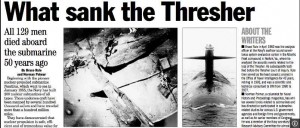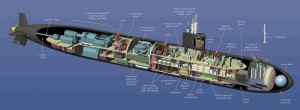by Jack
Nuclear Sub Thresher Sinks, All Hands Lost! So read the headlines in 1963. Our most advanced nuclear sub went down with all hands. On April 10th a surface support ship, the Skylark, received several messages from the Thresher: Garbled, “Experiencing minor difficulty. … Have positive angle. … Attempting to blow. … Will keep you informed.” If the situation continued to worsen, I’m sure they were thinking they could blow the ballast tanks and surface, but strangely this didn’t happen? The Thresher was lost. For many years we never knew what happened. This is the story of the subs final minutes and what sunk her.
 52 years later, the mystery of its sinking in deep water still lingered until 2014. However, new deep diving technology has allowed the first photographic evidence to confirm theories and added to this was declassified information from sonobouys, taken into total that gives naval investigators a real good idea what really happened.
52 years later, the mystery of its sinking in deep water still lingered until 2014. However, new deep diving technology has allowed the first photographic evidence to confirm theories and added to this was declassified information from sonobouys, taken into total that gives naval investigators a real good idea what really happened.
Our first nuclear powered sub, the Nautilus, went to sea in January 1955, since then the Navy has built 200 nuclear submarines of all types. They’ve been proven extremely safe and have logged millions of miles, but with two exceptions. The subs Thresher and the Scorpion. The latter was lost in 1968.
For 5 decades naval investigators believed the most likely cause of the Thresher disaster was due to a silver soldered waterline in the engine compartment that burst and released a spray of water onto a nearby circuit board. This could have resulted in a vessel-wide electrical failure. This could have triggered an emergency shut down of the nuclear reactor. The sub would have been without power and unable navigate as it slipped deeper and deeper into the abyss, but for some reason unknown to the crew they couldn’t blow their ballast tanks, ice had formed over the vents.
Can you imagine what must have been going through the minds of the crew as the sub lost power, they couldn’t blow their tanks and they didn’t know why. They sank lower and lower, drifting slowly passed the maximum allowable safe depth of 1400 feet.
The creaks and groans on the compressing hull would have been heard throughout the sub, water lines would start leaking, then their joints would start bursting, as one valve after another was shut to stop the fluids. I imagine the engine room would have been the worst scene. There would be a mad scramble of highly trained men trying to restart the reactor as they were blasted by noisy jets of high pressure water coming from many directions. And then there would be the yelling over the awful sounds of the hull straining to keep the water out. Each noisy crack, each metallic screech of bending metal could be their last. Sailors not at their posts would likely be praying under the glow of red emergency lights as their sub drifted ever deeper.
In the control room and attack center, all eyes would be the depth meter, but without power there is little they could do except wait to see if the reactor could be restarted. Everything rested on that reactor! Although they did have an auxiliary diesel engine, it was useless at this depth. However, there was a very, very slight chance they could have ducted their fresh air in it’s intake and hoped they could vent the diesel exhaust into the crew compartment just long enough to buy some time, even a few minutes to get the reactor started.
The Evidence: What is now known is the Thresher’s hull was designed to operate down to 1000′, but it could dive below that to a depth of about 1400′ if needed. The crush depth of the hull was estimated to be around 1950′ and that translates to about 850 PSI on the hull.
The last words from the Thresher the number “900.” Then nothing. The number 900 was extremely significant because 900 would have been the depth of the sub showing it was well [beyond] the predicted crush depth and yet here they were still alive, still fighting against the clock to restore power and surface. It was about 09:17:02. Each second…another foot down as the sub struggled to survive. At this depth, it was nothing short of amazing that the Thresher even alive and still savable…they had reached 2300 feet! This was unheard of for a submarine and it’s never been surpassed to this day.
Given the time from the automatic reactor shut down until this frantic point, it’s quite possible that the reactor came on line and the submarine did began to restore maneuvering power, but now they were below 2400 feet. This is the point when the hull absolutely could not stand one more pound of pressure and then WHAM! It suffered a catastrophic crushing event.
“The Thresher’s collapse event signal was detected by multiple SOSUS arrays as an extremely high-amplitude event at ranges as great as 1,300 nautical miles. The characteristics of that acoustic event confirmed that the Thresher’s pressure hull collapsed or “imploded” at 09:18:24 at a depth of about 2,400 feet (i.e., more than 400 feet below her predicted collapse depth).
The Thresher’s pressure hull and all sea-connected piping systems had survived well beyond their design specifications. The analysis of the SOSUS detection of the collapse event — the bubble-pulse frequency — also indicated that the pressure hull and all internal compartments were destroyed in about one-tenth of a second, significantly less than the minimum time required for perception of the event by the men on board.
Measurements made during the instrumented sinking of the discarded diesel-electric submarine Sterlet in 1969 are consistent with the conclusion that the water-ram produced by the initial breaching of the Thresher’s pressure hull at 2,400 feet entered the pressure hull with a velocity of about 2,600 mph. That force would have ripped asunder the pressure hull longitudinally and vertically, as verified by photographs of the Thresher wreckage.” Reported in Navytimes magazine
It is now beyond reasonable doubt that the Thresher suffered from an electrical bus failure, which shut down the submarine’s main coolant pumps causing the instant reactor to do an emergency shut down or scram. In the early model nuclear subs it was almost impossible to do a rapid restart to regain propulsion. It is suspected that ice prevent them from blowing ballast and thus the Thresher slowly sank toward the ocean floor — a depth of 8,400 feet — with 129 men on board.
It would seem a mistake to hold sea trials where the ocean floor is so deep. A more reasonable depth would have been not over 1000 feet, so in the event of a catastrophic failure, the crew would have had time to do repairs and hopefully surface. But, at 8400 feet the sub was beyond recovery even for investigative purposes. Such as simple decision in hindsight, but it seems also simple in foresight…stupid is often the prime cause for casualty in our military. Case in point, during WWII the Admiral of the Navy, Ernest J. King, rejected England’s advice to form protective convoys and use destroyers and corvettes to escort them. He also refused to black out our coastal lights that were silhouetting our ships against the shore making them easier to spot and torpedo.
This time was known among German submarine commanders as the American shooting season. We lost 609 ships totaling 3.1 million tons and thousands of lives, against a loss of only 22 U-boats. This was roughly one quarter of all shipping sunk by U-boats during the entire Second World War. Historian Michael Gannon called it “America’s Second Pearl Harbor” and placed the blame for the nation’s failure to respond quickly to the attacks on the inaction of Admiral Ernest J. King, commander-in-chief of the U.S. fleet.

